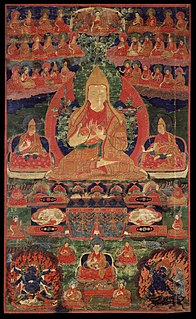
The Gelug is the newest of the four major schools of Tibetan Buddhism. It was founded by Je Tsongkhapa (1357–1419), a Tibetan philosopher, tantric yogi and lama and further expanded and developed by his disciples.
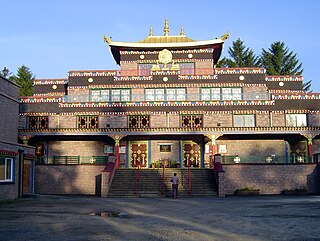
Kagyu Samye Ling Monastery and Tibetan Centre is a Tibetan Buddhist complex associated with the Karma Kagyu school located at Eskdalemuir, Scotland.

The sixteenth Gyalwa Karmapa, Rangjung Rigpe Dorje was the spiritual leader of the Karma Kagyu lineage of Tibetan Buddhism. Followers believed him to be part of the oldest line of reincarnate lamas in Vajrayana Buddhism, known as the Karmapas, whose coming was predicted by the Buddha in the Samadhiraja Sutra. The 16th Karmapa was considered to be a "living Buddha" and was deeply involved in the transmission of the Vajrayana Buddhism to Europe and North America following the Chinese invasion of Tibet. He had many monikers, including “King of the Yogis”, and is the subject of numerous books and films.
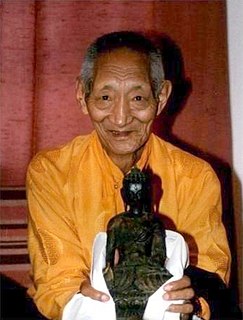
Kalu Rinpoche was a Buddhist lama, meditation master, scholar and teacher. He was one of the first Tibetan masters to teach in the West.

With nearly 250,000 Buddhists, Brazil is home to the third-largest Buddhist population in the Americas, after the United States and Canada. Buddhism in Brazil consists of practitioners from various Buddhist traditions and schools. A number of Buddhist organisations and groups are also active in Brazil, with nearly 150 temples spread across the states.
In Tibetan Buddhism, Ngöndro refers to the preliminary, preparatory or foundational practices or disciplines common to all four schools of Tibetan Buddhism and also to Bon. They precede deity yoga.

Mindrolling Jetsün Khandro Rinpoche is a lama in Tibetan Buddhism. Born in Kalimpong, India and the daughter of the late Mindrolling Trichen, Khandro Rinpoche was recognized by Rangjung Rigpe Dorje, 16th Karmapa at the age of two as the reincarnation of the Great Dakini of Tsurphu Monastery, Urgyen Tsomo, who was one of the most well-known female masters of her time. Khandro Urgyen Tsomo was the consort to Khakyab Dorje, 15th Karmapa Lama (1871–1922) and recognised in this Buddhist tradition as an incarnation of Yeshe Tsogyal. Her name is in fact her title, Khandro being Tibetan for dakini and rinpoche an honorific usually reserved for tulkus that means "precious one."
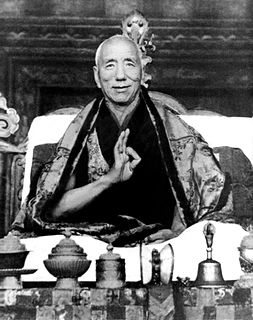
Dzongsar Khyentse Chökyi Lodrö was a Tibetan lama, a master of many lineages, and a teacher of many of the major figures in 20th-century Tibetan Buddhism. Though he died in 1959 in Sikkim, and is not so well known in the West; he was a major proponent of the Rimé movement within Tibetan Buddhism, and had a profound influence on many of the Tibetan lamas teaching today.

Chagdud Tulku was a Tibetan teacher of the Nyingma school of Vajrayana Tibetan Buddhism. He was known and respected in the West for his teachings, his melodic chanting voice, his artistry as a sculptor and painter, and his skill as a physician. He acted as a spiritual guide for thousands of students worldwide. He was the sixteenth tülku of the Chagdud line.
Phowa is a tantric practice found in both Hinduism and Buddhism. It may be described as "transference of consciousness at the time of death", "mindstream transference", "the practice of conscious dying", or "enlightenment without meditation". In Tibetan Buddhism phowa is one of the Six yogas of Naropa and also appears in many other lineages and systems of teaching.

Old Ghoom Monastery is the popular name of Yiga Choeling. The monastery belongs to the Gelukpa or the Yellow Hat sect and is known for its 15 feet (4.6 m)-high statue of the Maitreya Buddha. The external structure of the building was established in 1850 by the Mongolian astrologer and monk Sokpo Sherab Gyatso, who was head of the monastery until 1905.

Patrul Rinpoche (1808–1887) was a teacher and author from the Nyingma school of Tibetan Buddhism.
Khunu Lama Tenzin Gyaltsen, 1894–1977, known also as Negi Lama Tenzin Gyaltsen, Tenzin Gyaltsen, and various other names like Kunu Rinpoche, Kunu Lama and Negi Lama, was born in 1894 in the village of Sunam which lies in the forest-clad Kinnaur district of India in the western Himalayas. Khunu Rinpoche was neither a tulku nor a Buddhist monk but a layman who took the lay practitioner's vows.
Richard Barron is a Canadian translator who specializes in the writings of Longchenpa. He has served as an interpreter for many lamas from all four schools of Tibetan Buddhism, including his first teacher, Kalu Rinpoche. He completed a traditional three year retreat in 1980 at Kagyu Ling in France, and later became a close student of the late Chagdud Tulku Rinpoche. He is currently engaged in a long-term project to translate the Seven Treasuries of Longchenpa. He has been a Tsadra Foundation fellow since 2000.

Jetsunma Ahkon Lhamo is a tulku within the Palyul lineage of the Nyingma tradition of Tibetan Buddhism. She gained international attention when she, a western woman, was enthroned as a reincarnated lama. Since the mid-1980’s she has served as spiritual director for Kunzang Odsal Palyul Changchub Choling, a Buddhist center in Poolesville, Maryland, which includes a large community of western monks and nuns. She also founded a center in Sedona, Arizona, U.S.A., and has small communities of students in California and Australia. Ahkon Lhamo has been described by her teachers, Tibetan lamas Penor Rinpoche, Gyaltrul Rinpoche, as well as others such as Jigme Phuntsok, as a dakini or female wisdom being.
Orgyen Kusum Lingpa (1934-2009) was a Tibetan terton and Nyingma lineage holder within Tibetan Buddhism. His name means "Holder of the Sanctuary of the Trikaya of Oddiyana Padmasambhava."
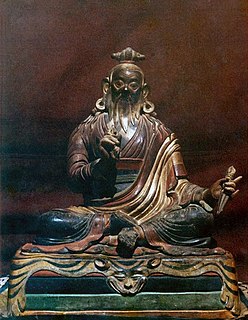
Dudjom Lingpa (1835–1904) was a Tibetan meditation master, spiritual teacher and tertön. He stands out from the norm of Tibetan Buddhist teachers in the sense that he had no formal education, nor did he take ordination as a monk or belong to any established Buddhist school or tradition of his time.

Phakchok Rinpoche is a teacher of the Nyingma lineage and chief lineage holder of the Taklung Kagyu lineage of Tibetan Buddhism. He is Vajra Master of Ka-Nying Shedrup Ling monastery, abbot of several monasteries in Nepal, and assists monasteries and practice centers in Tibet. In addition, he serves as Director of the Chokgyur Lingpa Foundation, a nonprofit organization engaged in a wide range of humanitarian projects.

The Tibet Center, also known as Kunkhyab Thardo Ling, is a dharma center for the study of Tibetan Buddhism. Founded by Venerable Khyongla Rato Rinpoche in 1975, it is one of the oldest Tibetan Buddhist centers in New York City. The current director is Khen Rinpoche Nicholas Vreeland, the abbot of Rato Dratsang monastery. Philip Glass assisted with the founding of The Tibet Center. Since 1991 TTC has invited and hosted the 14th Dalai Lama for teaching events in New York in partnership with the Gere Foundation.
Padma Gargyi Wangchug or Padma Gargyi Wangchuk is a Tibetan name which may refer to one of the following people:















